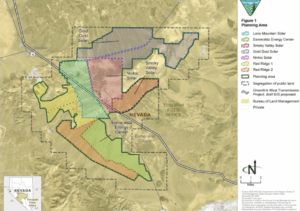Key Takeaways
The Trump administration canceled the proposed Esmeralda 7 Solar Project in Nevada, which would have been the largest solar facility in the nation.
The 6.2-gigawatt project would have comprised seven separate solar power generation projects with battery storage, occupying 118,000 acres of land and adding roads and transmission lines.
The Department of the Interior recently canceled the project’s environmental impact statement, essentially canceling the project.
The Department of the Interior indicates that developers can still get permits for the individual projects, with each requiring a full review, new environmental studies, and new mitigation plans.
At least 35 commercial-scale solar power projects that were under preliminary review by the Department of the Interior when President Trump took office still await action.
The Trump administration canceled the proposed Esmeralda 7 Solar Project in Nevada that would have been among the world’s largest solar power facilities and the largest in the United States. According to UPI News, the 6.2-gigawatt project would have built seven solar power-generation projects with battery storage within the Esmeralda site that would have occupied 118,000 acres of land in Nevada’s Esmeralda County and about 30 miles west of Tonopah and 270 miles northwest of Las Vegas. In addition to covering a huge area of desert lands, the project would have also included miles of roads and associated transmission lines.
The Bureau of Land Management (BLM) recently canceled the environmental impact statement of the proposed facility, canceling the project. According to Politico, in July 2024, the BLM under the Biden administration issued a draft programmatic environmental impact statement for the project and had planned to issue a final review document in April, but it was delayed under the Trump administration.
Some believe that the project may not be dead. The Department of the Interior indicated that developers could still get permits for their individual projects. NextEra Energy, one of the developers, plans to continue its work. Other developers include Leeward Renewable Energy, Arevia Power, ConnectGen, and Invenergy. Each subproject would need its own full review, new environmental studies, and new mitigation plans.

Actions of the Trump Administration
Interior Secretary Burgum directed his department to eliminate policies granting “preferential treatment” for wind and solar development on federal lands and waters and issued guidance stating that he would review procedural decisions for those projects. The order authorizes Burgum to conduct “elevated review” of activities ranging from leases to rights of way, construction and operational plans, and grants and biological opinions. He also signed an order that requires Interior to consider “capacity density” when evaluating solar and wind projects because they take up more land than other kinds of energy, taking over coveted farmland.
The new review requirements for wind and solar projects have slowed their development and have canceled some. The Interior Department is also investigating bird deaths and other impacts on wildlife and plant life by large solar and wind projects. The Esmeralda 7 project, for example, would have negatively impacted archaeological sites, rare plants, bighorn sheep habitat, and wilderness quality lands.
Other Solar Projects Await Action
Via Politico, at least 35 commercial-scale solar power projects that were under preliminary review by BLM when President Trump took office still await action, including final environmental impact statements for the 700-megawatt-capacity Copper Rays Solar Project, the 400-megawatt Purple Sage Solar Project, and the 300-megawatt Bonanza Solar Project, all of which are located in Nevada. Another Nevada solar power project, New Era Energy’s 200-megawatt Dodge Flat II, is still in progress and is expected to generate power by June 2027. Nevada’s vast open lands, marked by mining and sparse populations, are considered ideal testbeds for large-scale solar. Nevada already has more solar jobs per capita than any other state, according to 2023 Interstate Renewable Energy Council data.
Two major solar projects that were issued records of decision in the final weeks of the Biden administration are in limbo — the 600-megawatt Jove Solar Project in southwest Arizona and the 400-megawatt Rough Hat Clark County Solar Project in southern Nevada.
Analysis
Solar and wind are intermittent technologies dependent on the weather to create energy. When the sun is not shining and the wind is not blowing, they must be backed up by other reliable technologies, usually gas or coal, or very expensive, large storage batteries that collect excess electricity when available. The costs of the backup technology are generally not considered when the costs of wind and solar power are discussed, making them seem less expensive than what they are on a system cost and comparable basis.
While the flaws of solar and wind projects raise questions regarding the extent to which federal land managers should prioritize their construction, Interior’s cancellation of the Esmeralda 7 Solar Project continues the trend — started by President Obama’s cancellation of the Keystone XL Pipeline — of presidents canceling energy projects they disapprove of for political reasons. Preventing future abuses of presidential power requires Congressional action limiting presidential discretion over approving projects.
For inquiries, please contact [email protected].



